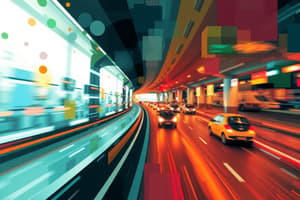Podcast
Questions and Answers
What significant step in ITS development occurred in the 1980s?
What significant step in ITS development occurred in the 1980s?
The first traffic signal control systems using computer technology were deployed in various cities.
Which act endorsed federal funding for ITS projects in the 1990s?
Which act endorsed federal funding for ITS projects in the 1990s?
The Intermodal Surface Transportation Efficiency Act (ISTEA).
What organization was established in 1994 to advocate for ITS deployment?
What organization was established in 1994 to advocate for ITS deployment?
ITS America.
In what year was the National ITS Architecture developed?
In what year was the National ITS Architecture developed?
What technological advancements were seen in the 2010s regarding ITS?
What technological advancements were seen in the 2010s regarding ITS?
What program initiated by the FHWA in 1986 laid the groundwork for ITS development in the U.S.?
What program initiated by the FHWA in 1986 laid the groundwork for ITS development in the U.S.?
What was the focus of the first Intelligent Transportation Systems Strategic Plan developed in 1992?
What was the focus of the first Intelligent Transportation Systems Strategic Plan developed in 1992?
What major trend in ITS is anticipated for the 2020s?
What major trend in ITS is anticipated for the 2020s?
What role does continuous monitoring play in Intelligent Transportation Systems (ITS)?
What role does continuous monitoring play in Intelligent Transportation Systems (ITS)?
How does Smart Transportation utilize data to enhance transportation networks?
How does Smart Transportation utilize data to enhance transportation networks?
What is meant by connectivity in the context of Smart Transportation?
What is meant by connectivity in the context of Smart Transportation?
Describe the significance of real-time information in Smart Transportation.
Describe the significance of real-time information in Smart Transportation.
What are some benefits of automation in Smart Transportation systems?
What are some benefits of automation in Smart Transportation systems?
What is the primary purpose of ITS in transportation?
What is the primary purpose of ITS in transportation?
What are Traffic Management Information Systems designed to do?
What are Traffic Management Information Systems designed to do?
How do Traveler Information Systems benefit users?
How do Traveler Information Systems benefit users?
What role do Control Technologies play in ITS?
What role do Control Technologies play in ITS?
What types of data do Traffic Management Information Systems collect?
What types of data do Traffic Management Information Systems collect?
Which systems are focused on improving public safety in transportation?
Which systems are focused on improving public safety in transportation?
What is one key outcome of implementing ITS?
What is one key outcome of implementing ITS?
How do Traveler Information Systems facilitate informed decision-making?
How do Traveler Information Systems facilitate informed decision-making?
What types of technologies are categorized under ITS?
What types of technologies are categorized under ITS?
Why is optimizing traffic flow important in Intelligent Transportation Systems?
Why is optimizing traffic flow important in Intelligent Transportation Systems?
What is the relevance of user interfaces in Intelligent Transportation Systems (ITS)?
What is the relevance of user interfaces in Intelligent Transportation Systems (ITS)?
Define interoperability in the context of ITS.
Define interoperability in the context of ITS.
What considerations are important for effective ITS planning?
What considerations are important for effective ITS planning?
How does the logical architecture of an ITS differ from its physical architecture?
How does the logical architecture of an ITS differ from its physical architecture?
What components are represented in the physical architecture of an ITS?
What components are represented in the physical architecture of an ITS?
What does the institutional architecture of an ITS address?
What does the institutional architecture of an ITS address?
List two types of architectures relevant to ITS and briefly describe one.
List two types of architectures relevant to ITS and briefly describe one.
Why is stakeholder involvement crucial in ITS planning?
Why is stakeholder involvement crucial in ITS planning?
Explain the role of standards and protocols in an ITS.
Explain the role of standards and protocols in an ITS.
What is the importance of assessing the relationships among ITS components in its logical architecture?
What is the importance of assessing the relationships among ITS components in its logical architecture?
What are some clear goals that can be established for Intelligent Transportation Systems (ITS)?
What are some clear goals that can be established for Intelligent Transportation Systems (ITS)?
Which stakeholders should be engaged in the ITS planning process?
Which stakeholders should be engaged in the ITS planning process?
Why is data collection and analysis crucial in the planning of ITS?
Why is data collection and analysis crucial in the planning of ITS?
What types of technologies might be assessed for integration within an ITS?
What types of technologies might be assessed for integration within an ITS?
Describe the purpose of system design and architecture in ITS planning.
Describe the purpose of system design and architecture in ITS planning.
What outcome does monitoring and evaluation seek to achieve in ITS?
What outcome does monitoring and evaluation seek to achieve in ITS?
How does stakeholder engagement benefit the ITS implementation process?
How does stakeholder engagement benefit the ITS implementation process?
What role does technology assessment play in the ITS planning process?
What role does technology assessment play in the ITS planning process?
What is the significance of objective setting in the context of ITS planning?
What is the significance of objective setting in the context of ITS planning?
What is typically included in the implementation strategy for ITS?
What is typically included in the implementation strategy for ITS?
Flashcards are hidden until you start studying
Study Notes
ITS Development Timeline
- Significant evolution of Intelligent Transportation Systems (ITS) spans six decades, focusing on safety, efficiency, and user experience.
- 1960s-1970s: Conceptual development phase.
- 1980s: Initial implementation, featuring computer-controlled traffic signals and the launch of the IVHS program by the FHWA.
- 1990s: Formalization through legislation like ISTEA, funding for ITS projects, and the establishment of ITS America.
- 2000s: Expansion and innovation in ITS technologies.
- 2010s: Rise of connected vehicles and smart technologies.
- 2020s: Emergence of smart cities and innovations shaping the future.
ITS Architecture
- ITS architecture includes logical, physical, and institutional components, ensuring interoperability and effective system functionality.
- Logical architecture outlines relationships and information flow among ITS components, emphasizing high-level system interactions.
- Physical architecture represents tangible components, showing how they integrate within real-world transportation environments.
- Institutional architecture focuses on governance and collaboration among stakeholders in transportation.
Types of ITS Technologies
- Traffic Management Information Systems: Collect and disseminate essential traffic condition data to optimize network performance.
- Traveler Information Systems: Provide timely information to transportation users, improving safety and travel decision-making.
- Control Technologies: Manage transportation operations and incident responses to enhance traffic flow and service coordination.
Key Features of ITS Planning
- Objective Setting: Define clear ITS goals such as congestion reduction and improved safety.
- Stakeholder Engagement: Collaborate with government, industry, and public participants to address user needs.
- Data Collection and Analysis: Leverage real-time data from sensors and historical records for informed decision-making.
- Technology Assessment: Evaluate current and emerging technologies for potential integration into transportation systems.
- System Design and Architecture: Develop interaction protocols among different ITS components.
- Implementation Strategy: Outline a phased deployment plan, budget considerations, and project timelines.
- Monitoring and Evaluation: Establish metrics for ongoing performance assessment and continuous improvement.
Smart Transportation
- Smart Transportation integrates advanced technologies and data analytics to enhance transportation efficiency and safety.
- Emphasizes connectivity among vehicles, infrastructure, and users for real-time data exchange.
- Utilizes data analytics for informed decision-making and operational optimization.
- Encourages automation in systems such as traffic management and autonomous vehicles to minimize human error.
- Provides real-time information to travelers via mobile apps and digital displays, improving overall travel experience.
Features of Smart Transportation
- Connectivity: Establishing networks for seamless data exchange across systems.
- Data Utilization: Analyzing extensive data from various sources to enhance operational efficiency.
- Automation: Deploying automated traffic systems and vehicles to streamline operations and reduce errors.
- Real-Time Information: Offering current updates on transportation conditions through digital platforms.
- Sustainability: Promoting eco-friendly practices and technologies within the transportation sector.
Studying That Suits You
Use AI to generate personalized quizzes and flashcards to suit your learning preferences.




